Wheel building - planning my first attempt
RubbishCyclist
Posts: 213
I've trued loads of wheels in the past and am fairly confident. My Shimano RS20's have just been sent back after i noticed the rim developing hairline cracks on all the drive side spoke holes. I'm holding out for a refund, i don't want another pair as i've lost confidence in them. Looking for replacements and all the factory build options have one thing in common - next to no spokes.
I've started looking at hand builds and got a couple of quotes but then i started thinking i'd like to build my own and learn how. I've spent hours reading and watching videos and i'm pretty excited to get going.
The build i have in mind is (I'm 90-95kg and pretty powerful)
Archetype 32 hole rims front and rear
Circus Monkey 32h hubs
ACI Alpine double butted spokes
I was going to use Ambrosio Zenith hubs but saw the circus monkey hubs and they seem to get really good reviews around the web. All this will come to about £215 which should blow away any factory build for the same price. Estimated weight around 1650gms and plenty of spokes.
What do people think, is there anything you'd change about my proposed build?
I've started looking at hand builds and got a couple of quotes but then i started thinking i'd like to build my own and learn how. I've spent hours reading and watching videos and i'm pretty excited to get going.
The build i have in mind is (I'm 90-95kg and pretty powerful)
Archetype 32 hole rims front and rear
Circus Monkey 32h hubs
ACI Alpine double butted spokes
I was going to use Ambrosio Zenith hubs but saw the circus monkey hubs and they seem to get really good reviews around the web. All this will come to about £215 which should blow away any factory build for the same price. Estimated weight around 1650gms and plenty of spokes.
What do people think, is there anything you'd change about my proposed build?
0
Comments
-
My first attempt at a wheel build (still in progress) was from a rubbish wheelset that I stripped, replaced the hub and built up again using my Turbo as a wheelstand. It's only still in progress as a nipple had been damaged before and I needed a replacement which I've now got, but not finished truing it.
Ok - I've probably not got the tension right as I don't have a tension meter - but judging by the pitch of the note as I pluck the spoke it's not far out.
Main problem that I can see is dishing - I've not got that right and it's slightly over to one side - I'll correct that when I sort out the wayward nipple ...
I'm only going to use it as a turbo wheel to start with - so at least I'll get an idea if I've cocked up without risking the bike! 0
0 -
you can dish at home but if there is a brake disk then it needs removed
stick wheel in frame and check where the rim is, then flip the wheel over (so cassette is on wrong side) and see if rim is in same place...... the rim should be in the middle
lube the nipples and spoke heads before assembly
you can measure tension by thread count on the spokes
don't rush it0 -
Hello mate,
Cheers for the reply, ive been practicing on an old wheel too. I basically loosened off all the nipples and started again. As you say dishing has been the tricky bit for me too although i think i'm just about there. Only thing being that i think some of my tensions are a bit all over as they dont all produce the same note....im enjoying it though0 -
estampida wrote:you can dish at home but if there is a brake disk then it needs removed
stick wheel in frame and check where the rim is, then flip the wheel over (so cassette is on wrong side) and see if rim is in same place...... the rim should be in the middle
lube the nipples and spoke heads before assembly
Good tip there, didnt think of that. What do you use to lube the nipples. Ive read linseed oil on the spoke threads is good?0 -
What do you do if the wheel is not in the middle?It's never too late to become what you might have been...........0
-
Well I've had a busy afternoon building a diy truing stand. It works really well for a first go and will do until I get the hang of it then may splash out on a park one
 0
0 -
Rob.M wrote:What do you do if the wheel is not in the middle?
I think you then apply more tension on one side to bring it into the centre. Assuming the spokes are the right length.... that's the bit I'm worrying most about!0 -
You can't apply tension if it is already to tight though. It may require slackening off. But best not to get to that stage - slowly slowly is answer!!!
 0
0 -
Nice piece of kit you built there... like it!!
 left the forum March 20230
left the forum March 20230 -
ugo.santalucia wrote:Nice piece of kit you built there... like it!!

Thank you! Needs a little bit more work but I'm pleased with it seems to do the job. What are your thoughts on my proposed build? Are aci spokes any good? They seem cheaper than DT Swiss and sapim but that worries me although alot of people on the tinternet say they are fine just not marketed as well.
Really looking forward to getting started just waiting to hopefully get my rs20s refunded. Lesson learned there.0 -
RubbishCyclist wrote:ugo.santalucia wrote:Nice piece of kit you built there... like it!!

Thank you! Needs a little bit more work but I'm pleased with it seems to do the job. What are your thoughts on my proposed build? Are aci spokes any good? They seem cheaper than DT Swiss and sapim but that worries me although alot of people on the tinternet say they are fine just not marketed as well.
Really looking forward to getting started just waiting to hopefully get my rs20s refunded. Lesson learned there.
Last year I have used about 3000 Alpina DB spokes... not a single snapped one... good enough?
They are as good as the other brands. Never used Cyrcus Monkey, but they are probably Taiwanese hubs in disguise, some good, some bad, hard to say.
Your set will weigh more like 1750left the forum March 20230 -
Ah that's good enough for me then

The circus monkey hubs look pretty nice and get good reviews and I won't be using them in the winter/rain so I'll give them a go. If they build up around 1750 I'll be happy....my estimate was just going by quoted weights. I weigh 95kg so an extra 100gms is neither here nor there.....should last a damn sight longer than any factory wheels....I think I've seen the light 0
0 -
RubbishCyclist wrote:Well I've had a busy afternoon building a diy truing stand. It works really well for a first go and will do until I get the hang of it then may splash out on a park one

Why bother? Save your money, that looks great!! It's never too late to become what you might have been...........0
It's never too late to become what you might have been...........0 -
Rob.M wrote:RubbishCyclist wrote:Well I've had a busy afternoon building a diy truing stand. It works really well for a first go and will do until I get the hang of it then may splash out on a park one

Why bother? Save your money, that looks great!!
Agree, you don't need a fancy gig to build nice wheelsleft the forum March 20230 -
Rob.M wrote:RubbishCyclist wrote:Well I've had a busy afternoon building a diy truing stand. It works really well for a first go and will do until I get the hang of it then may splash out on a park one

Why bother? Save your money, that looks great!!
Just paint it blue and get some stickers fitted if you want it to look like a Park one Yellow is the new Black.0
Yellow is the new Black.0 -
Haha well i'll start accumulating the parts i need soon and crack on with my first attempt.....cheers all0
-
Nice jig - any way you could be persuaded to post plans and details of whats needed so I can copy it?0
-
Built up my wheels finally after gradually getting the bits together, took me a few hours but they are running true. I used bike hub store hubs, total cost came to about £230 and they weigh 1650 grams on my scales including rim tape
They are Archetype rims, 28 front 32 rear, ACI alpine black spokes and brass nipples. The hubs weigh 310 grams for the set. Looking forward to my first ride on them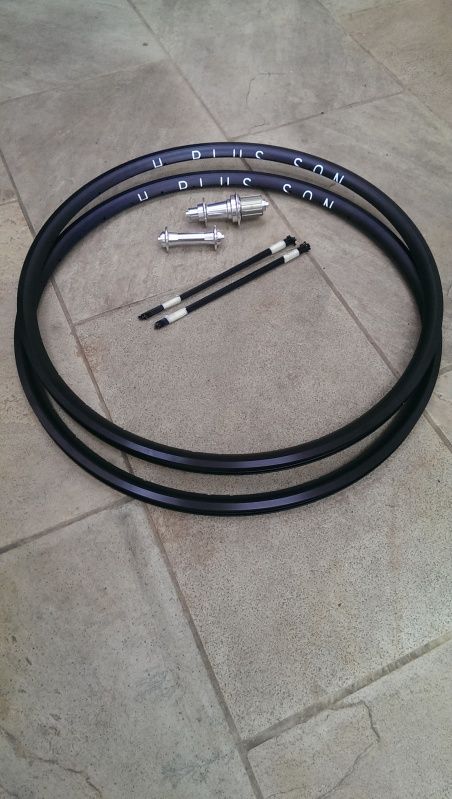
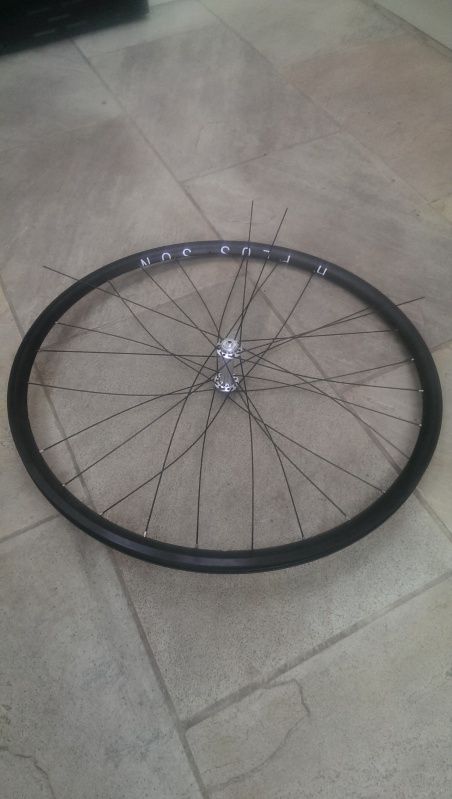
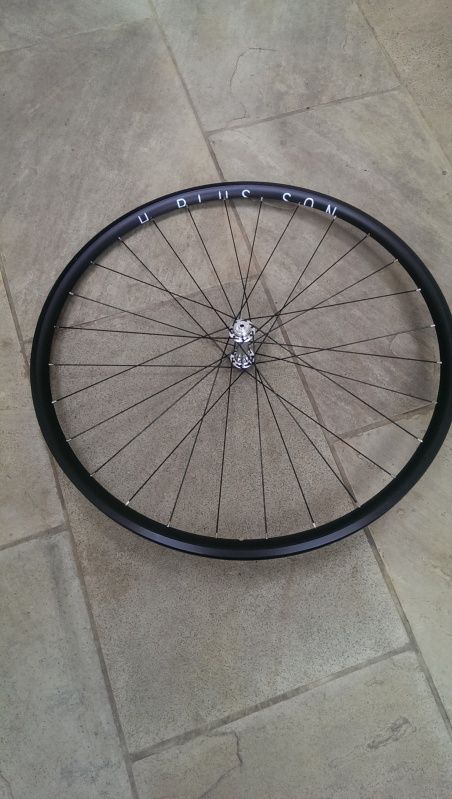
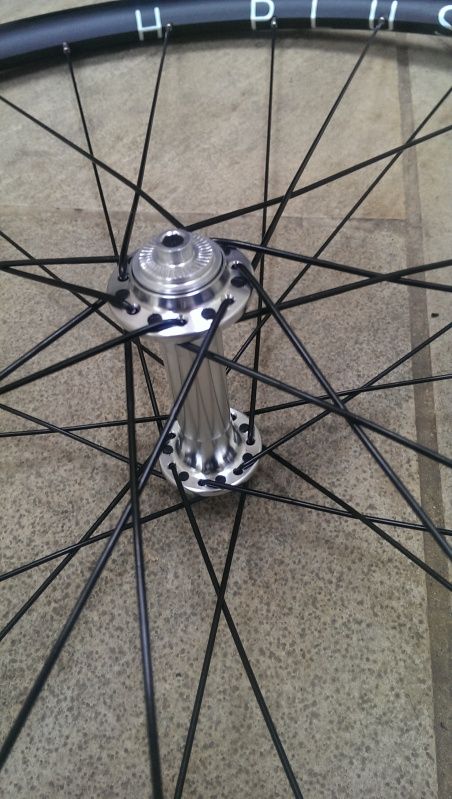

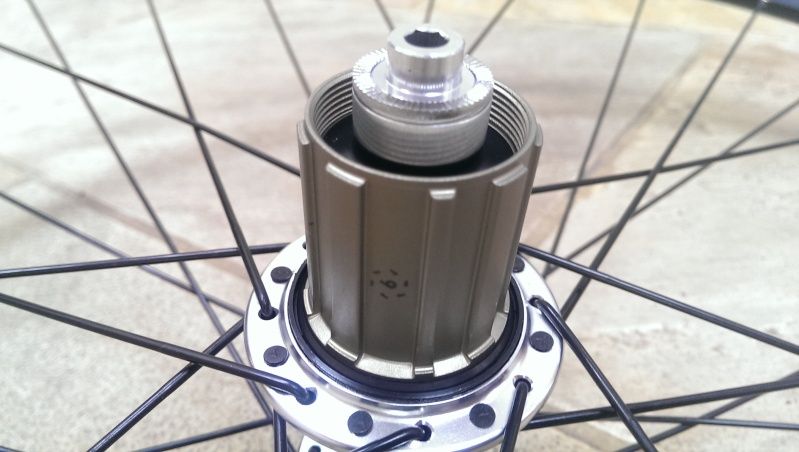
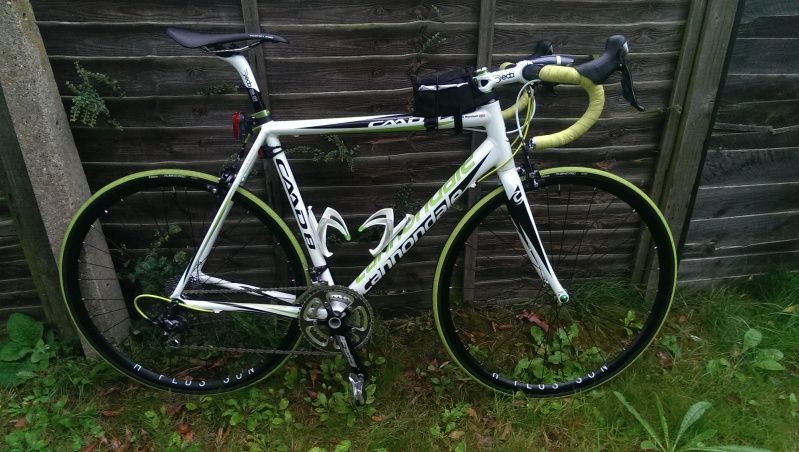 0
0 -
wishitwasallflat wrote:Nice jig - any way you could be persuaded to post plans and details of whats needed so I can copy it?
Yes sorry mate, didn't see your post, i'll try and put something together0 -
3 things that you need before building a wheel. Good dishing tool. Spoke tension meter(Park works great). And a GOOD wheelbuilding manual. Not having these items means you're guessing at dishing, guessing at spoke tension, and guessing about how it SHOULD be done. It's a proven recipe for a piece of junk wheel. Don't think you know what you're doing, know what you're doing.0
-
Circus Monkey = Bitex hubs. OK, cheap lightweight but bearings are weenie and wear quickly. For a heavier rider I'd go for Novatec / Ambrosio Zenith (same thing).
FWIW counting nipple turns is OK for initial build/ trueing but is not accurate enough for tension - there are too many other variables.
Tension meters are necessary for low spoke / carbon rims but don't think they are necessary for regular 32 hole shallow rim builds - I've had wheels survive years without one.
The one thing to avoid are alloy nipples - more trouble than they are worth - cutting CX ray spokes out because the hidden nipples have corroded to mush is a right pain!Make mine an Italian, with Campagnolo on the side..0 -
A nice tip, I think I picked up from Roger Mussons book, is to paint the jig frame white and the indicators black.
It really helps you see the light closing in and out in the final stages of trueing, especially under artificial light.
I think you will find once you have built a couple of wheels on your jig. Unless your planning a career in wheel building, that it will be all you will ever need.
Have a play with feeler gauges and you will be astonished how good your eyes are at detecting tiny tolerances.
EnjoyMud to Mudguards. The Art of framebuilding.
http://locksidebikes.co.uk/0 -
woolwich wrote:A nice tip, I think I picked up from Roger Mussons book, is to paint the jig frame white and the indicators black.
It really helps you see the light closing in and out in the final stages of trueing, especially under artificial light.
I think you will find once you have built a couple of wheels on your jig. Unless your planning a career in wheel building, that it will be all you will ever need.
Have a play with feeler gauges and you will be astonished how good your eyes are at detecting tiny tolerances.
Enjoy
And here's your latest work
http://paolocoppo.drupalgardens.com/con ... ing-leaves
I am a bit envious, as I have built many hundred wheels, but never had the chance to build these rims!left the forum March 20230 -
woolwich wrote:A nice tip, I think I picked up from Roger Mussons book, is to paint the jig frame white and the indicators black.
It really helps you see the light closing in and out n the final stages of trueing, especially under artificial lightI expected that.
I think you will find once you have built a couple of wheels on your jig. Unless your planning a career in wheel building, that it will be all you will ever need.
Have a play with feeler gauges and you will be astonished how good your eyes are at detecting tiny tolerances.
Enjoy
Thanks for the comments, I actually did something similar, I placed a sheet of white paper under the jig which helped immensely. The hardest bit was working against spoke twist. Any tips?
Had my first ride on them and they are great. So compliant over rough surfaces in no way harsh. No brake rub out of the saddle and if I break a spoke atleast I should get home...sadly after riding in the wet the surface has already started to wear but I expected that. Very pleased with my handywork.
My jig is going to be modified this week as it force too much so it makes fine tuning tricky so I'm going to brace it more.0 -
ugo.santalucia wrote:woolwich wrote:A nice tip, I think I picked up from Roger Mussons book, is to paint the jig frame white and the indicators black.
It really helps you see the light closing in and out in the final stages of trueing, especially under artificial light.
I think you will find once you have built a couple of wheels on your jig. Unless your planning a career in wheel building, that it will be all you will ever need.
Have a play with feeler gauges and you will be astonished how good your eyes are at detecting tiny tolerances.
Enjoy
And here's your latest work
http://paolocoppo.drupalgardens.com/con ... ing-leaves
I am a bit envious, as I have built many hundred wheels, but never had the chance to build these rims!
Stunning!0 -
Thank you. The tubs have been glued and and I am looking forward to an amazing compliant ride very soon. They used to race these in Paris-Roubaix to soak up the bumps. Should be fun.
Tips for spoke twist. I would stick to one type/thickness of spoke to begin with until you get the feel for it. Different thickness's and makes respond differently, so it helps to get some basic competency first, particularly before using the very thin ones.
In the later stages of trueing, I think I tend to rewind the spoke about half of what I turned it. So tighten 1/4 turn, then back off an 1/8th. Then 1/8th and 1/16th etc.
You can feel spoke twist with your thumb if you have the feel. I think some use masking tape although I have not experimented.
I think when I started wheel building that I attributed to much to spoke twist, when in fact I was not getting aggressive enough with de-stressing and de-stressing as I went along.
Glad your enjoying your wheels.Mud to Mudguards. The Art of framebuilding.
http://locksidebikes.co.uk/0 -
woolwich wrote:Thank you. The tubs have been glued and and I am looking forward to an amazing compliant ride very soon. They used to race these in Paris-Roubaix to soak up the bumps. Should be fun.
Tips for spoke twist. I would stick to one type/thickness of spoke to begin with until you get the feel for it. Different thickness's and makes respond differently, so it helps to get some basic competency first, particularly before using the very thin ones.
In the later stages of trueing, I think I tend to rewind the spoke about half of what I turned it. So tighten 1/4 turn, then back off an 1/8th. Then 1/8th and 1/16th etc.
You can feel spoke twist with your thumb if you have the feel. I think some use masking tape although I have not experimented.
I think when I started wheel building that I attributed to much to spoke twist, when in fact I was not getting aggressive enough with de-stressing and de-stressing as I went along.
Glad your enjoying your wheels.
Depending on how you do the destressing process you can also be allowing the spokes to unwind. I do it in the stand; working my way round the wheel and squeezing adjacent spokes together hard enough to pull the rim over. I once did this with bits of tape on the spokes (for other reasons) and noticed that the spokes adjacent to the ones I was squeezing were rotating as they were briefly unloaded by the rim moving across the hub.- - - - - - - - - -
On Strava.{/url}0 -
I recently built my first wheel for my commuter and used this book as a reference The Professional Guide to Wheel Building by Roger Musson. I found it very helpful and it also has intrusions for building your own truing stand, dish gauge and nipple driver.0


